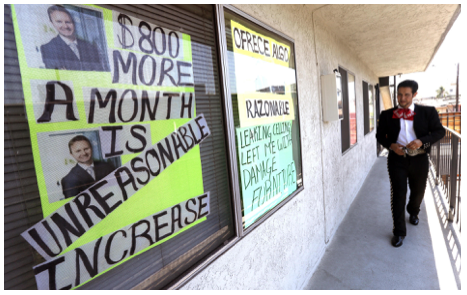CommentsKILLING A CULTURE-In cities around the world, gentrification has long been a threat to culture — and Los Angeles is no exception. Just take the recent L.A. Times article on the plight of mariachis in Boyle Heights. Yet in a piece that’s clearly about gentrification, the Times doesn’t once use the word. What’s going on?
For years, reporters and academics have been documenting how gentrification can make culture disappear as longtime residents are forced out of their neighborhoods. Not too long ago, for example, The Guardian explained that gentrification endangered vital, longtime music scenes in New Orleans, Austin and Nashville.
On September 9, the Los Angeles Times appeared to offer another disturbing report about gentrification’s street-level destruction. Titled, “As Rents Soar in L.A., Even Boyle Heights’ Mariachis Sing the Blues,” the article details how the “culture” of mariachis, “long an iconic part of Los Angeles,” is in danger because of “soaring rents.”
The piece capably reports the struggles of mariachis, and the fact that mariachi culture may be facing extinction. Not only are mariachis having trouble paying for housing that’s becoming increasingly unaffordable, but their working-class neighbors are being forced out of the community — the same people who normally employ a mariachi. It’s a brutal, vicious circle.
So far, so good. But after reading through the piece, one realizes the Times says nothing about gentrification.
The Times, for instance, doesn’t mention Boyle Heights’ ongoing gentrification battles — a standard journalism procedure to give context. That’s particularly odd since the newspaper constantly covered anti-gentrification protests over a Boyle Heights coffee shop.
Even Times columnist Steve Lopez, who’s normally level-headed about things, went to Boyle Heights to write about the protests, only to belittle community activists and describe their actions as “ridiculous.”
In addition, the word “gentrification” is totally absent in the mariachi piece, although there’s this paragraph.
“It was not an easy job to begin with,” the Times notes, “with lots of worn shoe leather and the everlasting hope that love or nostalgia will turn into a customer paying for a song. But now, in what was once an affordable neighborhood, the rising rents in Los Angeles are pricing out the musicians’ customers — immigrants and blue-collar residents.”
And this paragraph: “Tyler Anderson, co-director of LACCLA, said the conflict at the Boyle Heights apartment building speaks to a trend of investors converting affordable housing units into luxury ones.”
A once affordable neighborhood? Immigrants and blue-collar residents getting the heavy-ho? A trend of affordable housing converted into luxury units? A disappearing culture? Sounds like gentrification to us. In fact, according to the city’s own data, Boyle Heights is definitely dealing with gentrification and displacement issues.
In 2016, Mayor Eric Garcetti’s Innovation Team (i-team) created a database called the “Los Angeles Index of Neighborhood Change.” The i-team looked at 111 areas in LA — from downtown to Hollywood to Venice — and used “six demographic measures indicative of gentrification” to come up with a ranking system. In other words, the i-team measured citywide gentrification.
Downtown was ranked number one as the most gentrified area in LA Bel Air, of course, saw no gentrification — it ranked number 111. Boyle Heights? Number 26. Out of 111, that’s a high ranking — and the i-team used data from 2000 through 2014. Things may have gotten worse.
The i-team also created the Los Angeles Index of Displacement Pressure, which measures displacement across LA — from “very high” to “low.” The database not only shows where residents are facing “massive” rent increases today, but can help predict unaffordable housing trends in the future.
Based on more real-time data compared to the neighborhood change database, the index shows that Boyle Heights is facing “medium” displacement pressure. Working- and middle-class residents are feeling the squeeze, with possibly more rising rents to come.
Just as one mariachi told the Times, “We don’t know how much money we’ll be making. The uncertainty is really bad. Everything is on the rise… The gas, the food. Everything.”
So, what’s happening at the Times? Why the unwillingness to follow standard journalism procedure and include at least one sentence about previous news coverage on gentrification that obviously relates? Why the refusal to call a duck a duck? Why the focus on rising rents but nothing about gentrification?
As the old saying goes, silence speaks volumes.
In the meantime, one of L.A.’s most treasured cultures, including the mariachis themselves, may become victim of our city’s gentrification crisis. Mayor Eric Garcetti and City Council President Herb Wesson have the indexes, so when are they going to roll out data-driven interventions?
Want to be heard on this issue? Contact Mayor Eric Garcetti and City Council President Herb Wesson.
(Patrick Range McDonald is website editor and senior researcher at Coalition to Preserve LA.) Photo: Genaro Molina / Los Angeles Times. Prepped for CityWatch by Linda Abrams.
-cw
















